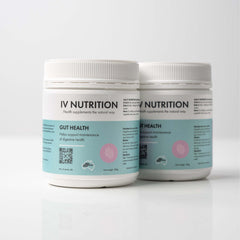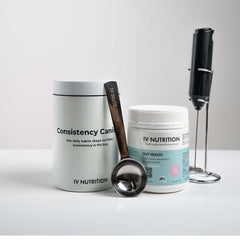What Is the Best Thing for Heartburn? A Science-Backed, Clinical (and a Little Fun) Guide to Finding Real Relief
Heartburn: that burning sensation creeping up your chest, usually at the worst possible time—after your favorite spicy dish or right before bed. While it might feel like your esophagus is throwing a temper tantrum, it’s actually a common medical issue affecting more than 60 million Americans every month (American College of Gastroenterology).
But when it comes to taming the burn, everyone seems to have an opinion: pop an antacid, avoid tomatoes, chew some gum, stand on your head (okay, maybe not that one). With so much conflicting advice out there, you’re probably wondering: What is the best thing for heartburn—really?
This comprehensive, science-backed guide breaks down the root causes of heartburn, clinical treatment options, lifestyle tweaks that actually work, and the surprising role your gut microbiome plays. We'll even introduce a powerful prebiotic fiber made from virgin-manufactured sugarcane that might just be your gut’s secret weapon.
First, What Is Heartburn?
Heartburn is the symptom of acid reflux—when stomach acid backs up into the esophagus. Your stomach is built to handle acid; your esophagus? Not so much.
This happens when the lower esophageal sphincter (LES)—a muscular ring at the junction between your esophagus and stomach—relaxes when it shouldn’t, letting stomach contents flow backward.
Chronic or frequent heartburn (more than twice per week) may indicate gastroesophageal reflux disease (GERD), a more serious and ongoing condition.
Common Symptoms of Heartburn
-
Burning sensation in the chest or throat
-
Sour or bitter taste in the mouth
-
Discomfort after eating, especially spicy or fatty foods
-
Worsening symptoms when lying down or bending over
-
Persistent cough or sore throat
If these sound familiar, you’re not alone. But treating symptoms without understanding the underlying cause is like slapping duct tape on a leaky pipe. So let’s look at what’s actually triggering the burn.
What Causes Heartburn?
There are multiple culprits:
1. Dietary Triggers
-
Spicy foods
-
Acidic foods (tomatoes, citrus)
-
Fatty or fried foods
-
Caffeine
-
Chocolate
-
Carbonated drinks
-
Alcohol
2. Lifestyle Habits
-
Lying down after eating
-
Overeating or eating large meals
-
Smoking
-
Wearing tight clothing around the waist
3. Medical Conditions
-
GERD
-
Hiatal hernia
-
Pregnancy (thanks, progesterone)
-
Obesity
4. Medications
Certain meds relax the LES or irritate the esophagus:
-
NSAIDs (ibuprofen, aspirin)
-
Calcium channel blockers
-
Antidepressants
-
Sedatives
What Is the Best Thing for Heartburn? Let’s Explore Your Options
Now we get to the meat (or, perhaps more appropriately, the oatmeal) of this post: how to actually fix it.
We’ll break it down into four science-backed categories: quick fixes, long-term strategies, medical treatments, and gut health support.
1. Quick Relief: Fast-Acting Fixes
Antacids
These neutralize stomach acid almost instantly.
Examples:
-
TUMS (calcium carbonate)
-
Rolaids
-
Mylanta
Pros: Rapid relief
Cons: Temporary, doesn’t treat root cause
Note: Overusing antacids can cause electrolyte imbalances or rebound acid production. They’re not a long-term solution.
Alginates
Create a barrier between stomach contents and the esophagus.
Example: Gaviscon
Evidence: A 2020 meta-analysis showed alginates can reduce heartburn severity and frequency.
2. Long-Term Lifestyle Adjustments
These might not be sexy, but they’re effective and foundational.
Dietary Tweaks
-
Eat smaller meals more frequently
-
Avoid known triggers (track yours with a food journal)
-
Try a low-acid, Mediterranean-style diet, which has been shown to reduce reflux symptoms (JAMA Otolaryngology)
Timing and Positioning
-
Don’t lie down within 2-3 hours of eating
-
Elevate the head of your bed 6–8 inches
-
Sleep on your left side—this position keeps acid below the LES
Weight Management
Excess abdominal fat can increase pressure on the stomach, forcing acid upward.
Fun fact: Losing even 10–15 pounds can significantly reduce GERD symptoms (NEJM Study).
3. Medical Treatments
If symptoms are persistent, your doctor may recommend medication.
H2 Blockers
Reduce acid production.
Examples:
-
Pepcid (famotidine)
-
Tagamet (cimetidine)
Good for occasional or mild symptoms.
Proton Pump Inhibitors (PPIs)
Powerfully suppress stomach acid production.
Examples:
-
Omeprazole (Prilosec)
-
Esomeprazole (Nexium)
-
Pantoprazole (Protonix)
Pros: Very effective
Cons: Long-term use may cause:
-
Vitamin B12 deficiency
-
Increased risk of C. difficile infection
-
Impaired calcium absorption (FDA Warning)
Translation: They work, but they’re not a forever solution.
4. The Gut Health Connection: Could Microbiome Imbalance Be Causing Heartburn?
Emerging science is shining a light on a surprising contributor to reflux: gut dysbiosis.
Your microbiome plays a role in:
-
Gastric motility (how food moves through your gut)
-
Gut-brain signaling (yes, your gut talks to your brain)
-
Immune regulation
-
Inflammation modulation
According to a 2021 study in Microorganisms, people with GERD often show reduced microbial diversity and imbalances in beneficial bacteria like Lactobacillus and Bifidobacterium (Study here).
How Prebiotics Can Help with Heartburn (and More)
Enter prebiotics—the fermentable fibers that feed your good gut bacteria and help restore balance.
When your gut microbiome is thriving, it produces short-chain fatty acids (SCFAs) like butyrate, acetate, and propionate. These reduce inflammation and support proper LES function.
Why Prebiotics, Not Just Probiotics?
While probiotics introduce beneficial strains, prebiotics nourish the native strains you already have, helping them flourish.
They also:
-
Enhance digestion
-
Reduce bloating and constipation (often linked to reflux)
-
Improve mucosal lining health
Clinical Support:
A 2020 review in Nutrients confirmed that prebiotic supplementation improved upper GI symptoms and helped regulate motility in patients with reflux and indigestion (Full Text).
Featured Gut Support: IV Nutrition’s Sugarcane Prebiotic Fiber
Let’s talk about a standout product that checks all the boxes:
IV Nutrition’s Virgin Manufactured Sugarcane Prebiotic Fiber
What Makes It Special?
-
Clean source: Derived from virgin-manufactured sugarcane—not byproduct junk
-
Plant-based & non-GMO
-
Rich in fermentable soluble fiber
-
Gentle on the stomach—no bloating or gassy aftermath
-
Great for daily use
It supports:
-
Balanced microbiome
-
Reduced inflammation
-
Regular digestion
-
Less pressure buildup in the stomach = less reflux
Bonus: Get Your First Tub FREE
Yep, when you subscribe, your first tub is 100% free—so your gut can feel better while your wallet takes a nap.
How to Incorporate Prebiotics into a Heartburn-Friendly Routine
Step 1: Start low and slow—1/2 scoop mixed in water or a smoothie.
Step 2: Take with or after meals to support digestion and gut fermentation.
Step 3: Combine with lifestyle changes (like meal timing and posture) for compounded benefits.
Step 4: Track your symptoms over 2–4 weeks. You may notice:
-
Less bloating
-
More regular digestion
-
Reduced heartburn episodes
What About Natural Remedies?
Here are a few additional science-backed options to consider:
| Remedy | How It Helps | Evidence |
|---|---|---|
| Aloe vera juice | Soothes esophageal lining | Pilot study shows symptom relief |
| Ginger root | Anti-inflammatory, supports gastric emptying | Research supports use in nausea and reflux |
| Slippery elm | Mucilage coats and protects GI tract | Traditional use, limited clinical trials |
| Chamomile tea | Calms the digestive tract and nerves | Mild relaxant effect, anecdotal support |
Always talk to a healthcare professional before starting herbs or supplements, especially if you’re taking medications.
Prebiotics vs. Antacids: Why Treat the Soil, Not Just the Fire
Antacids are like fire extinguishers. Prebiotics are like fixing the faulty wiring that started the fire in the first place.
You can certainly use both, but if you want lasting relief from heartburn, address the root cause, not just the symptoms.
Final Thoughts: So, What Is the Best Thing for Heartburn?
There’s no one-size-fits-all answer—but the most sustainable solution lies in:
-
Understanding your triggers
-
Adopting smart lifestyle changes
-
Using medication when needed (strategically)
-
Supporting your gut with real, functional nutrition—like prebiotic fiber
And when it comes to choosing a prebiotic, IV Nutrition’s sugarcane-based formula stands out as a clean, effective, gentle, and clinically smart addition to your toolkit.
👉 Try your first tub for FREE here
Because heartburn relief should be less about guesswork—and more about giving your gut what it actually needs.





